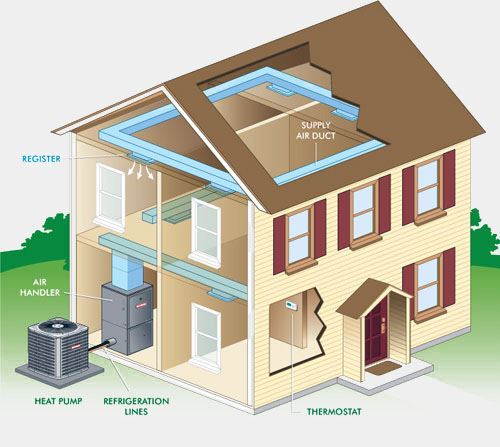
Austin Cooling System Heat Pumps
Travis County: Austin, Round Rock, Cedar Park, Pflugerville, Leander, TX
Heat pumps are a mechanical-compression cycle refrigeration system that can be reversed to either heat or cool a controlled space.
Installation for this type of system typically consists of two parts: an indoor unit called an air handler and an outdoor unit similar to a central air conditioner, but referred to as a heat pump. A compressor circulates refrigerant that absorbs and releases heat as it travels between the indoor and outdoor units.
Central and Ground-Source Heat Pumps
In the warmer months, the heat pump acts like an air conditioner, removing heat from the air inside your home and transferring it outside. While during colder months, heat from outdoor air is extracted and transferred to the interior of your home. Believe it or not, even a 32º Fahrenheit day produces enough heat to warm a home via a heat pump.
Efficient centralized heat pumps have a SEER of 15 or more while very efficient heat pumps can have a SEER of 18 to 21. Ground-source heat pumps can achieve efficiencies of up to 300%.
Ductless Heat Pumps
Ductless heat pumps save energy and money because they can be used for zone cooling (only cooling parts of the house) and because they avoid the large fan energy and duct losses typically associated with central ductwork. The advanced inverter technology incorporated into these units has also increased their efficiency at a wider temperature range so that backup heating is unnecessary. Ductless heat pump models are available with SEER ratings as high as 26.
Ductless mini-splits generally cost about 30% more than central heat pumps, not including the cost of ductwork for central systems. However, if you would need to install ducts to add a central AC system to your home, the ductless mini-split heat pumps may be a less expensive option up front. Ductless heat pumps are a good option for additions

Ductless mini-split air conditioning systems, which provide cooling but not heating, are also available. Mini-split AC systems could be an option in houses that use a non-ducted heating system that you aren’t ready to replace.
Absorption Heat Pumps
Absorption heat pumps, sometimes called gas-fired heat pumps, are essentially air-source heat pumps driven not by electricity, but by a heat source, such as natural gas, propane, solar-heated releasing water, or geothermal-heated water. The cooling version is called heat inside an absorption cooler or gas-fired cooler. It works on the same heat pump principle but is not reversible and cannot serve as a heat sources as well.
Although mainly used in industrial or commercial settings, absorption coolers are now available for large homes (4,000 ft or more). Absorption heat pumps for smaller homes are being developed. Absorption coolers and heat pumps have lower efficiencies than other heat pumps (1.2+ COP for heating; 0.7+ COP for cooling), but they can make use of solar energy, geothermal hot water, or other heat sources and may be cost-effective where electricity rates are very high.
